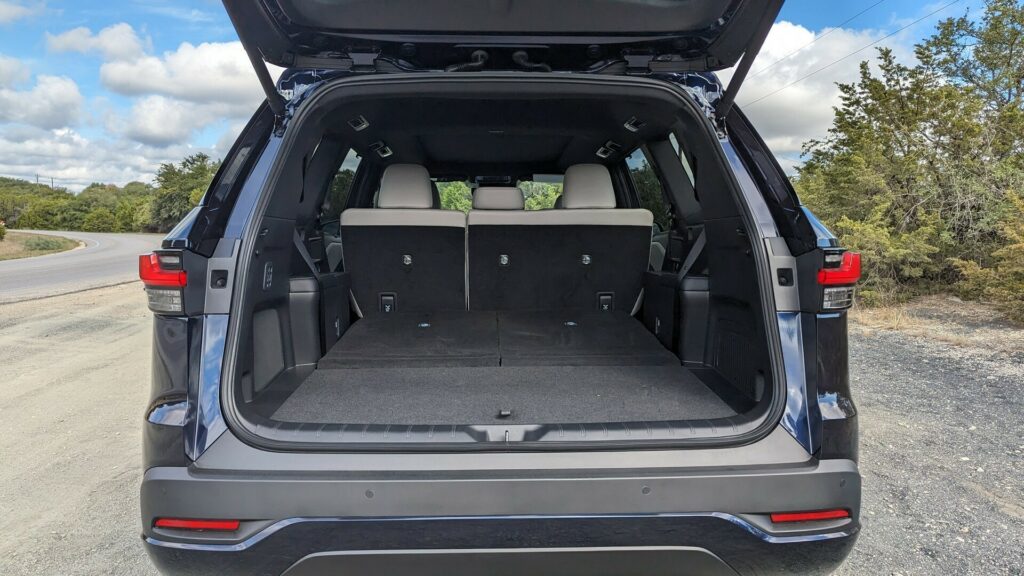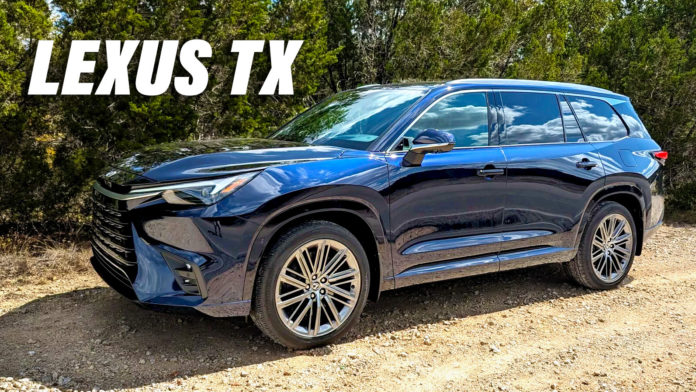Few things in life are assured besides death and taxes, but three-row crossovers are virtually guaranteed to print money. However, that’s not always the case as the Lexus RX L failed to entice buyers and was quickly discontinued.
Lexus has now gone back to the drawing board and created their first purpose-built model for North America. It’s the 2024 TX and it fills a sizable gap in the company’s lineup.
Lexus Goes Large
Pictures: Michael Gauthier / CarScoops
Consumers have adopted a bigger is better attitude and Lexus embraced that idea wholeheartedly as the TX measures up to 203.5 inches (5,169 mm) long and has a wheelbase that spans 116.1 inches (2,949 mm). That means the crossover is larger than the body-on-frame Lexus LX as well as competitors such as the Audi Q7, Acura MDX, and Infiniti QX60.
advertisement scroll to continue
Besides being big, the TX is notable for having a “Unified Spindle” front end that sees the traditional spindle grille relegated to the history books. In its place is a partially enclosed grille that features razor-like bars. It will take some getting used to, but Lexus says the aerodynamically optimized grille provides “excellent cooling performance” as well as a “sense of mass.”
The grille isn’t the only change as there’s a “functional crevasse” beneath the aluminum hood. It houses air intakes as well as a millimeter wave radar.
Pictures: Michael Gauthier / CarScoops
The rest of the crossover is more conventional as it sports LED lighting units, rain-sensing wipers, and aluminum roof rails. They’re joined by flowing bodywork, an expansive greenhouse, and blacked out rear pillars. Buyers will also find a slender rear light bar and a power liftgate with a kick sensor. 20-inch wheels come standard, while the 500h and 550h+ ride on massive 22-inchers.
Speaking of the 500h, it’s available exclusively in F Sport guise and is distinguished by sportier bumpers, dark chrome trim, and black roof rails. They’re accompanied by gloss black mirrors and F Sport badges on the front fenders.
A Spacious And Well-Equipped Interior
Pictures: Michael Gauthier / CarScoops
Three-row crossovers are all about the cabin and the TX puts its size to good use. First-row occupants will find tons of head- and legroom, and it’s easy to get comfortable in the standard eight-way power heated front seats.
The good news continues in the second row, which offers an impressive 39.5 inches (1,003 mm) of legroom. Bench seats come standard, but captain’s chairs are available on higher-end variants. Regardless of which is selected, both types of seats slide, fold, and recline.
The real star of the show is the third row, which is adult-friendly and easily accommodated this 6’2” reviewer. There’s plenty of headroom and legroom is good at 33.5 inches (851 mm). To put that number into perspective, the Infiniti QX60 only has 28 inches (711 mm) of room. The Audi Q7, Acura MDX, and Lincoln Aviator all have around 29.2 inches (742 mm), while the Volvo XC90 comes closest at 31.9 inches (810 mm).
The model also bests the BMW X7, which has 33.3 inches (846 mm) of third-row legroom. That being said, the TX falls short of the Mercedes GLS and its 34.6 inches (879 mm) of space. However, neither model competes with the Lexus as they’re nearly $30,000 more expensive.
Putting dimensions aside, third-row entry and egress is relatively easy and aided by a second row that slides forward at the touch of a button. While the third row lacks power on the entry-level trim, all other versions have a power-folding third row with power recline. That’s a nice touch and Lexus put power-folding third-row controls in the cargo area as well as in the second row and even in the first row via the infotainment system.
The TX has 20.2 cubic feet (572 liters) of cargo space behind the third row and that can be increased to a whopping 97 cubic feet (2,747 liters) by folding the second and third row down. That annihilates the competition as the Audi Q7 maxes out at 69.6 cubic feet (1,971 liters), while the Volvo XC90 offers 85.7 cubic feet (2,427 liters).
Besides being roomy, the Lexus TX has an upscale interior that features a 7- or 12.3-inch cluster display as well as a 14-inch infotainment system with cloud-based navigation as well as an intelligent assistant. The latter responds to natural language voice requests and owners can always use Android Auto or Apple CarPlay if preferred.
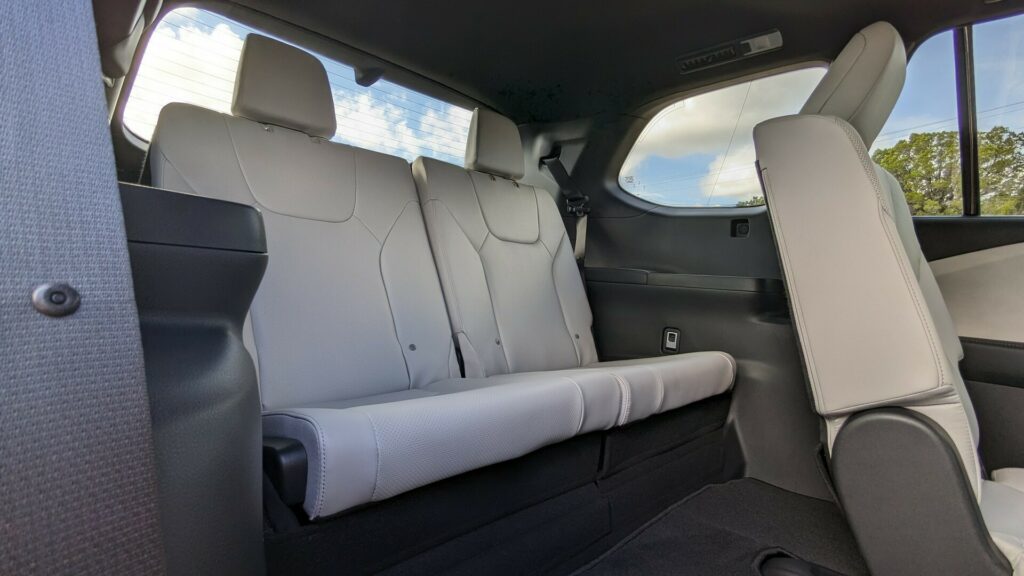
The entry-level TX comes nicely equipped with NuLuxe upholstery, a power tilt/telescopic steering column, and a wireless smartphone charger. They’re joined by an ambient lighting system, a tri-zone climate control system, and modular cup holders that are removable.
Higher-end variants up the ante with semi-aniline leather seats as well as heating and ventilation in the first two rows. Customers can also get a heated leather steering wheel, a panoramic glass roof, and a digital rearview mirror. Other highlights include a 21-speaker Mark Levinson audio system and a 1,500-watt power outlet in the cargo area of the hybrid.
Speaking of the TX 500h F Sport, the model has aluminum pedals, fancier scuff plates, and a sport steering wheel. Customers will also find sport seats that are so heavily bolstered, they’re uncomfortable for wider folks such as myself. While the seats felt slightly better after prolonged use, they’re overkill in the TX and I’d rather have something less aggressive.
The sport seats aren’t the only problem as the interior is plain and not very luxurious. While material quality is top notch and soft-touch accents are abound, the cabin doesn’t feel particularly special. Part of this can be chalked up to the dull atmosphere, which lacks excitement and visual interest. This has been a Lexus trend as of late and we’re not exactly a fan of the austere aesthetic.
A Powertrain For Everyone
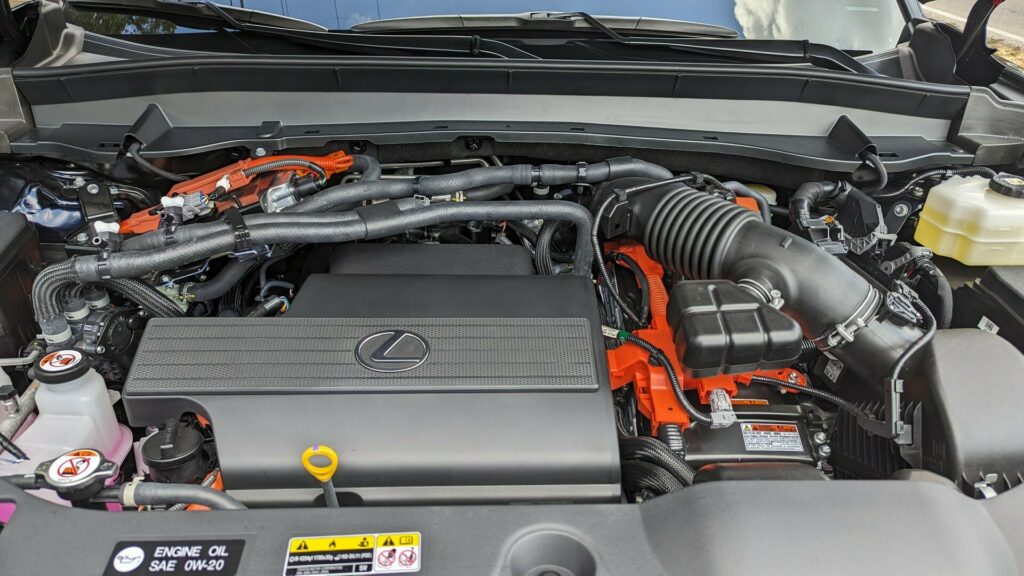
While most competitors only offer one or two engines, the Lexus TX has a powertrain for everyone. Kicking things off is a turbocharged 2.4-liter four-cylinder that produces 275 hp (205 kW / 279 PS) and 317 lb-ft (429 Nm) of torque.
That’s more than the Toyota Grand Highlander and is enough to beat the turbocharged 2.0-liter four-cylinders found in the Audi Q7, Cadillac XT6, and Volvo XC90. However, it’s a mixed bag when compared to the Acura MDX and Infiniti QX60 as both have more horsepower but less torque.
The turbocharged engine doesn’t seem overly refined, but it’s connected to a smooth shifting eight-speed automatic transmission. This setup enables the crossover to accelerate from 0-60 mph (0-96 km/h) in 7.8 seconds, when equipped with the optional all-wheel drive system.
While the performance is nothing to write home about, the TX 350 returns 21 mpg city, 27 mpg highway, and 23 mpg combined with front-wheel drive and 20 mpg city, 26 mpg highway, and 23 mpg combined with all-wheel drive. Those numbers are respectable for the segment and the highway ratings standout.
Customers looking for more performance can opt for the TX 500h. It has a hybridized powertrain that consists of a turbocharged 2.4-liter four-cylinder engine, a six-speed automatic transmission, a rear eAxle, and a small nickel metal hydride battery. This setup gives the all-wheel drive crossover 366 hp (273 kW / 371 PS) and 406 lb-ft (550 Nm) of torque.
That’s more than the Acura MDX Type S and it enables the TX 500h to accelerate from 0-60 mph (0-96 km/h) in 6.1 seconds. Furthermore, the electric motor allows for effortless launches and the hybrid tech barely makes its presence known.
However, you’ll notice it at the pump as the crossover is slated to return 27 mpg city, 28 mpg highway, and 27 mpg combined. Those are fantastic numbers for a large three-row crossover, especially one that’s performance-focused.
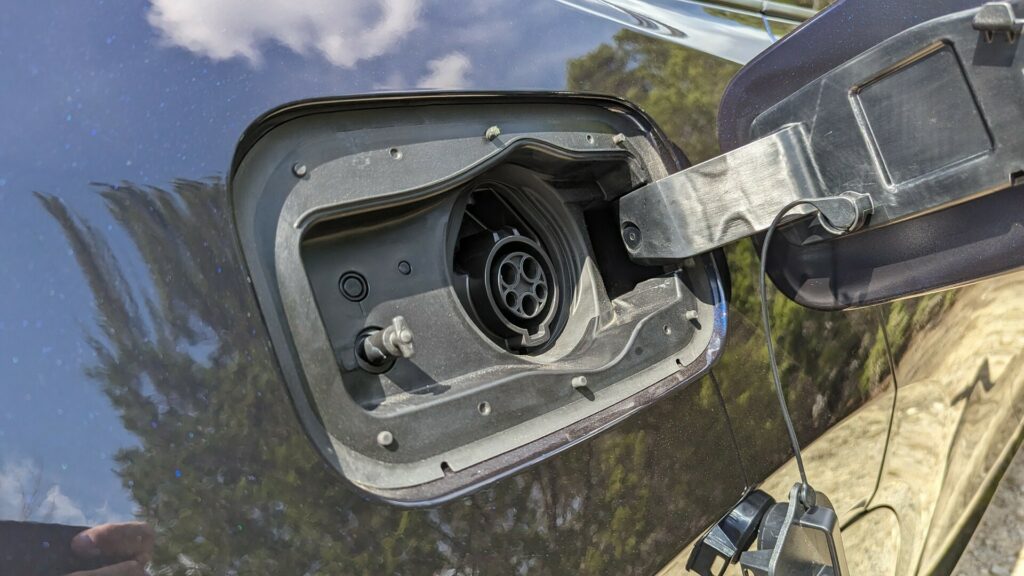
Last but not least, there’s the TX 550h+ plug-in hybrid. It has a 3.5-liter V6, two electric motors, and an 18.1 kWh lithium-ion battery pack. This gives the crossover a combined output of 404 hp (301 kW / 410 PS) and an electric-only range of 33 miles (53 km). The plug-in hybrid is also the fastest TX as it can hit 60 mph (96 km/h) in 5.9 seconds.
The driving experience is remarkably similar to the 500h as the crossover is quick and quiet. It’s not quite as sharp as its hybrid sibling, but the weight of the battery pack doesn’t make itself known around town.
While that’s good news, there’s little doubt the model will be tragically overpriced as the RX 450h+ plug-in hybrid starts at $70,080. That’s a shame, because the TX 550h+ is an interesting addition to the lineup and has enough electric-only range to handle short commutes.
A Comfortable And Capable Crossover
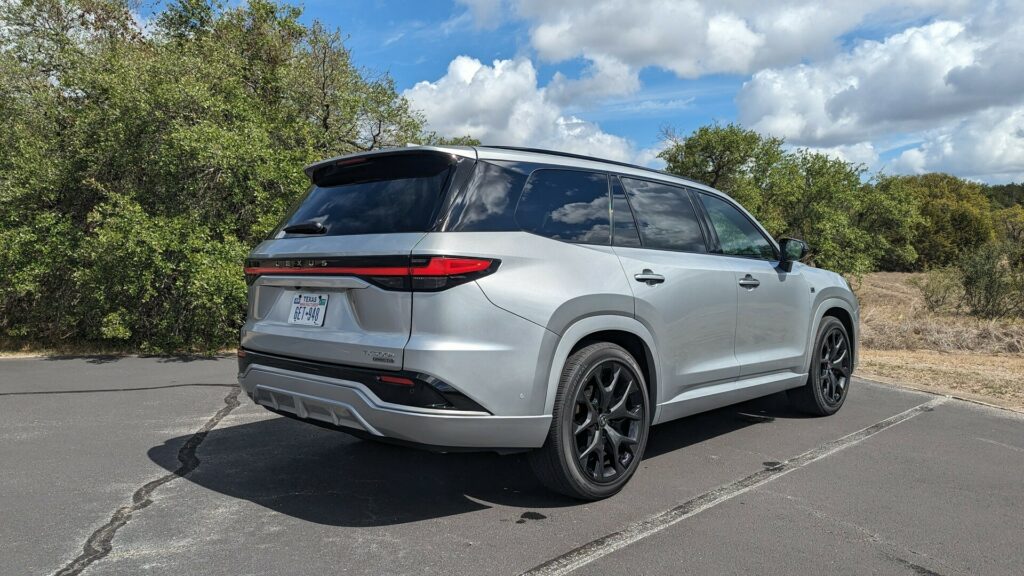
Like the RX, the TX rides on the GA-K platform and has a suspension that combines MacPherson struts up front with a multi-link rear. This is a winning combination as the crossover has remarkable road manners and a supremely comfortable ride.
Given the focus on comfort, it’s not surprising the electric power steering system is light and predictable. However, you can add heft by putting the crossover into Sport mode or fine-tuning the Custom mode to deliver a sportier driving experience.
The crossover is a capable handler and body roll is largely kept in check. However, if you push things, you’ll be reminded that the TX is a large crossover that weighs up to 5,400 lbs (2,449 kg). That being said, on the right road, the model is capable of delivering a smile or two. This is particularly true in the 500h and 550h+ as their Direct4 all-wheel drive system can send up to 80% of the power to the rear wheels.
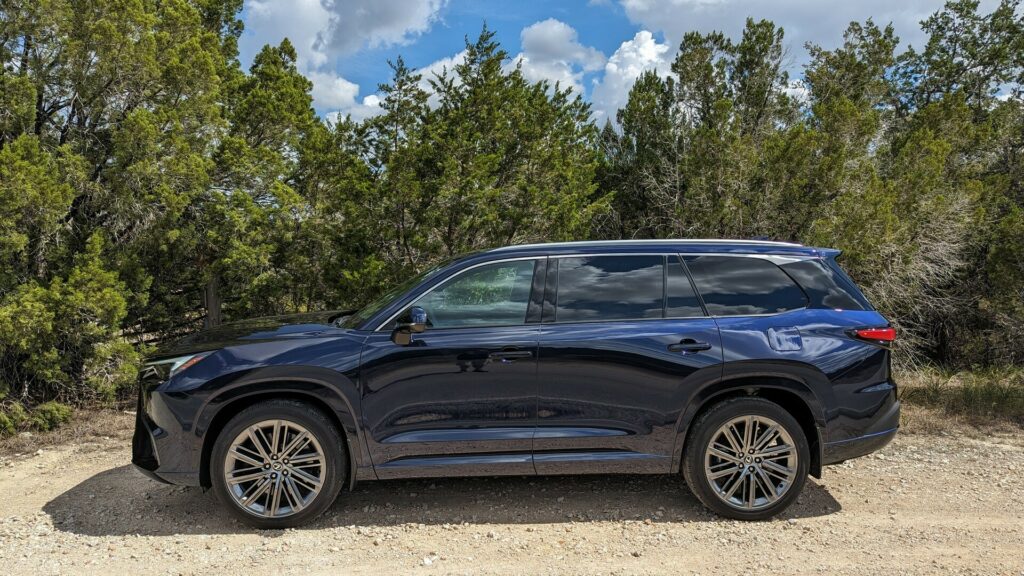
Other highlights include a well-mannered braking system and a 5,000 lbs (2,268 kg) towing capacity across the board. The latter trails a number of competitors and is left in the dust by the Audi Q7, which can tow up to 7,700 lbs (3,493 kg).
The TX 500h is the sportiest of the bunch and it comes standard with an Adaptive Variable Suspension that adjusts damping based on conditions. That isn’t the crossover’s only party trick as it has a Dynamic Rear Steering system, which can turn the rear wheels four degrees in the same or opposite direction as the front wheels.
This is designed to improve high-speed stability as well as low-speed maneuverability. The latter area is where the system shines as it enables the crossover to be remarkably nimble. We put that to the test during a tight U-turn and were pleasantly surprised to find the TX handled it with ease.
Buyers will also find a suite of standard driver assistance systems that includes All-speed Dynamic Radar Cruise Control, Lane Tracing Assist (Lane Centering), and Lane Departure Alert with Steering Assist. The model also has Road Sign Assist, a Pre-Collision System with Pedestrian Detection, and a Blind Spot Monitor with Rear Cross-Traffic Alert.
The Three-Row Crossover Customers Have Been Waiting For
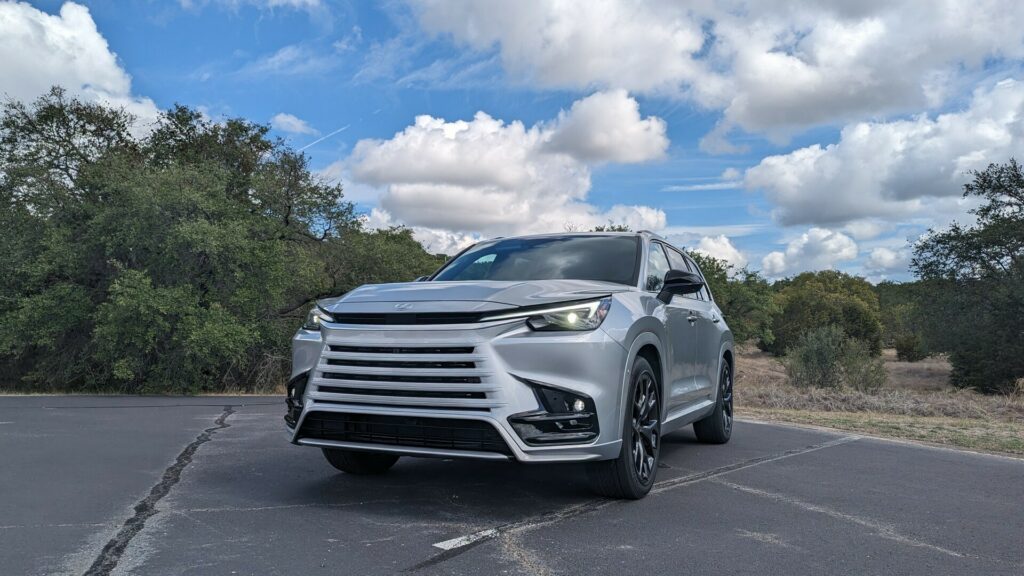
While Lexus took their sweet time creating a ‘proper’ three-row crossover, the wait was worth it as the TX is comfortable, spacious, and well-equipped.
Pricing isn’t too shabby either as the model starts at $55,050 and comes nearly loaded for $60,950. At the latter price point, you’ll find a heated leather steering wheel and semi-aniline leather seats with heating and ventilation up front. The TX 350 Luxury also has heated second-row seats, a power third row, and a panoramic glass roof, among other things.
Unfortunately, pricing is a double-edged sword as the excellent TX 500h starts at $69,350 and the 550h+ plug-in hybrid will undoubtedly be even more expensive. That isn’t the only issue as the interior isn’t very luxurious and the looks aren’t for everyone. However, if you’re looking for comfort and space, you could do a lot worse.
